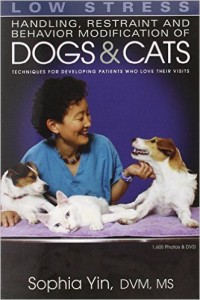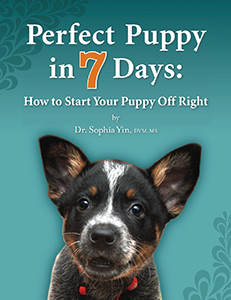Do you have a dog that you think has dominance aggression? A dog who’s confident and aggressive over many types of resources? As the top dog, he’s outgoing and rarely shows fear postures or what one might call “apologetic” behavior. One moment, he’s as charming as a Casanova on a first date. The next minute, he’s throwing more barks and bites than Mike Tyson at a pre-fight press conference. If so, read on.
Note: For the actual definition of dominance, go to the ”dominance controversy”.
In animal behavior, dominance is defined as a relationship between individuals that is established through force, aggression and submission in order to establish priority access to all desired resources (food, the opposite sex, preferred resting spots, etc). A relationship is not established until one animal consistently defers to another.
Dominance aggression would be the aggression that the higher ranking individual exhibits towards the lower ranking ones in order to “keep the lower ranking one in it’s place.”
How can a dog become so unpredictable and bossy?
This high and mighty behavior starts in puppyhood when the pooch is treated like a prince. He gets praise and petting for his slightest deeds and free food delivered on request like room service at the Hyatt. Then he wins tons of toys without even trying and the best human beds and couches to rest his bum. Most dogs who live the high-life just become spoiled brats.
But for some dogs with a more aggressive personality, this life without leadership or predictable and consistent rules creates a furry monster who aggressively claims ownership to any resource – food, toys, sleeping places, access to attention – that he wants. This fighting over multiple types of valued resources is called dominance aggression by behaviorists who study social hierarchies. And a dominance-submissive relationship between individuals exists only when one individual consistently backs down. In essence, some Fidos claim the household to be under their aggressive dictatorship.
In reality, dogs who are aggressive to family members RARELY actually have dominance aggression. What they generally have are situations where they guard multiple resources out of fear. For instance, you may have allowed them on the bed and then been shocked when they also decided to sleep on the couch. In your surprise you react angrily or indignantly approach them in an accusatory tone, ” Get off!” instead of calling them off in an instructive manner and then rewarding the more desirable behavior. Some dogs will “get off” when asked the first time. Others switch to the same reaction mode that you just exhibited. They go into a defense that escalates as you do because they are just reacting rather than thinking of another option out of the situation. Over time, the dog’s reaction in these situations may become worse because he’s learned to expect conflict in these situations and to react sooner and sooner.
There are inklings that this type of situation has caused your dog to be aggressive over multiple types of resources. For one, the dog does not have a confident personality, rather he may even act very needy around you. Secondly you may often see body postures of fear and anxiety in the conflict situations—cowering, head low, licking lips, averting gaze and more. (Refer to Low Stress Handling® Restraint and Behavior Modification of Dogs & Cats chapter 1 to see the signs of fear in dogs).
Luckily, regardless of whether the aggression is fueled by fear or your dog is truly high ranked (which is rare) our treatment is the same and it does not involve force.
How To End Rover’s Reign Using Your Brain Rather Than Your Brawn
You might think that, like wolves in a pack, baboons in a troop, or lions in a pride, the way to take charge of a dominant-aggressive dog is by calm, assertive force or even violence. The problem is that with animals, their reign is often short-lived, lasting only as long as they have the physical strength to prevail. Similarly with humans, only the strongest, most skilled members of the household can win physical altercations, leaving the majority of members to fend for themselves. Furthermore, such a butting of heads can temporarily suppress the aggression while making the underlying emotional state much worse. Since emotions guide behavior, the dog may outwardly hide his resentment when he’s not strong enough to fight, all-the-while seething inside. Then, when he can’t contain it anymore, he bites. Luckily because we humans have bigger brains, we can swiftly carry out a non-violent, long-lasting coup while changing Bowser’s entire attitude. Our carefully executed plan will help us with those rare dogs who are truly trying to vie for highest rank, as well as those who are reacting out of fear and have just not been taught more appropriate safe behaviors.
First Keep Yourself Safe
Avoid all situations that trigger a battle. This is a war of wills where you supposedly outsmart your less cerebral companion. If furniture is one of the resources Fido guards, then all human furniture is off bounds. Deny access to the room containing the cherished chair, barricade the bed with uncomfortable books or booby trap it with the electostatically charged Scatmat. Or just keep Rover on leash so you can pull him right off. Just be sure to do it in a ho-hum manner. For instance, nonchalantly take the leash and walk away unemotionally. Then reward him with a treat for following you off.
Next Take Control of All Important Resources
This includes food, furniture, toys, and anything else Rover likes including petting, praise, and playtime. Instead of his controlling these items, you’ll ration these resources as selectively as the Seinfeld Soup Nazi. Also control Rover’s freedom of movement by putting him on leash. For the next several days or week, he should be attached to you or tethered to a tie down in the house whenever people are at home with him. This will keep him from getting into situations that get him into trouble and provide you with a lot of opportunities to reward the desired behaviors.
Now, teach the ruling Rover to Say Please by Sitting Patiently to get what he wants. When Rover’s ravenous, let him see that you have a treat so that he knows what he can earn and then hold the food in your hand. At first he’ll wonder why the delay; usually, you deliver on demand. Just stand silently and stationary and when he finally sits, give him the treat before he has a chance to get up. Next, move a few steps and repeat this exercise. Practice this 10 or 20 times in row, and Rover’s light bulb is sure to stay lit.
Now Apply the Automatic Sit to Everything Rover Wants
From here on, Rover must automatically say please for everything he wants instead of automatically taking it for free. Wait for him to sit and look at you politely before tossing his toy, letting him out the door, or giving him a treat. Put his dog bowl in storage and make him earn each kibble of food and pat on the head by performing this and other behaviors that he knows. The goal is that he learns that this is just how his world now works. It has order and predictability. When he wants something, he doesn’t have to worry about guarding it. He’ll get what he wants when he sits politely and looks to you for permission. This program where he learns to say please by sitting, automatically, for everything he wants and he learns that sitting and patiently focusing on you is the only way he gets what he wants, is my version of the Learn to Earn Program. It teaches self-control, impulse control, and to look to humans for guidance and is a good foundation program for any dog who is anxious, aggressive, or lacks focus and attention.
Train Rover to Enjoy All Handling Procedures He Dislikes
For instance, if Fido growls and snaps when you handle his feet, work first on touching his feet or legs in a way where he barely responds, and pair this touching with treats. In order to make it clear that touching the feet equals tasty treats, only touch the feet while Fido’s getting treats and stop touching the feet as soon as he finishes the treat. When he consistently allows this level of handling then increase the intensity by, for instance, squeezing the toes, or holding the toenail trimmers near his feet. The goal is that at each step he ignores the handling and is only focused on the food. By only going to the next step of handling when he’s non-reactive at the current level, Rover can improve quickly, even over just several days to a week.
The best source for training dogs to love to be handled is (Low Stress Handling, Restraint and Behavior Modification of Dogs & Cats
The Attitude Change Can Be Fast
At first these changes are a challenge for owners. They want to pet the pooch when he pushes his way into their laps instead of ignoring him until he’s polite. Or they accidentally let him barrel by to get out the door rather than waiting for him to drop his derriere and look to them for direction. By bearing down and making all the changes at once, though, you make the message black and white. You’re telling him that you can set rules and be both predictable and consistent, so he should trust YOU to guide him instead of making his own rules. Once Rover gets the rules you’ve conveyed to him through your actions, the weight of trying to be in charge or wondering how he should react will be lifted off his shoulders. Furthermore, once asking politely is Rover’s new habit, you’ll only reward him when you decide he should have the reward. That way you remain the one in control, but you’re doing so in a predictable and non-threatening way that helps him understand what you want and strengthens your relationship.




